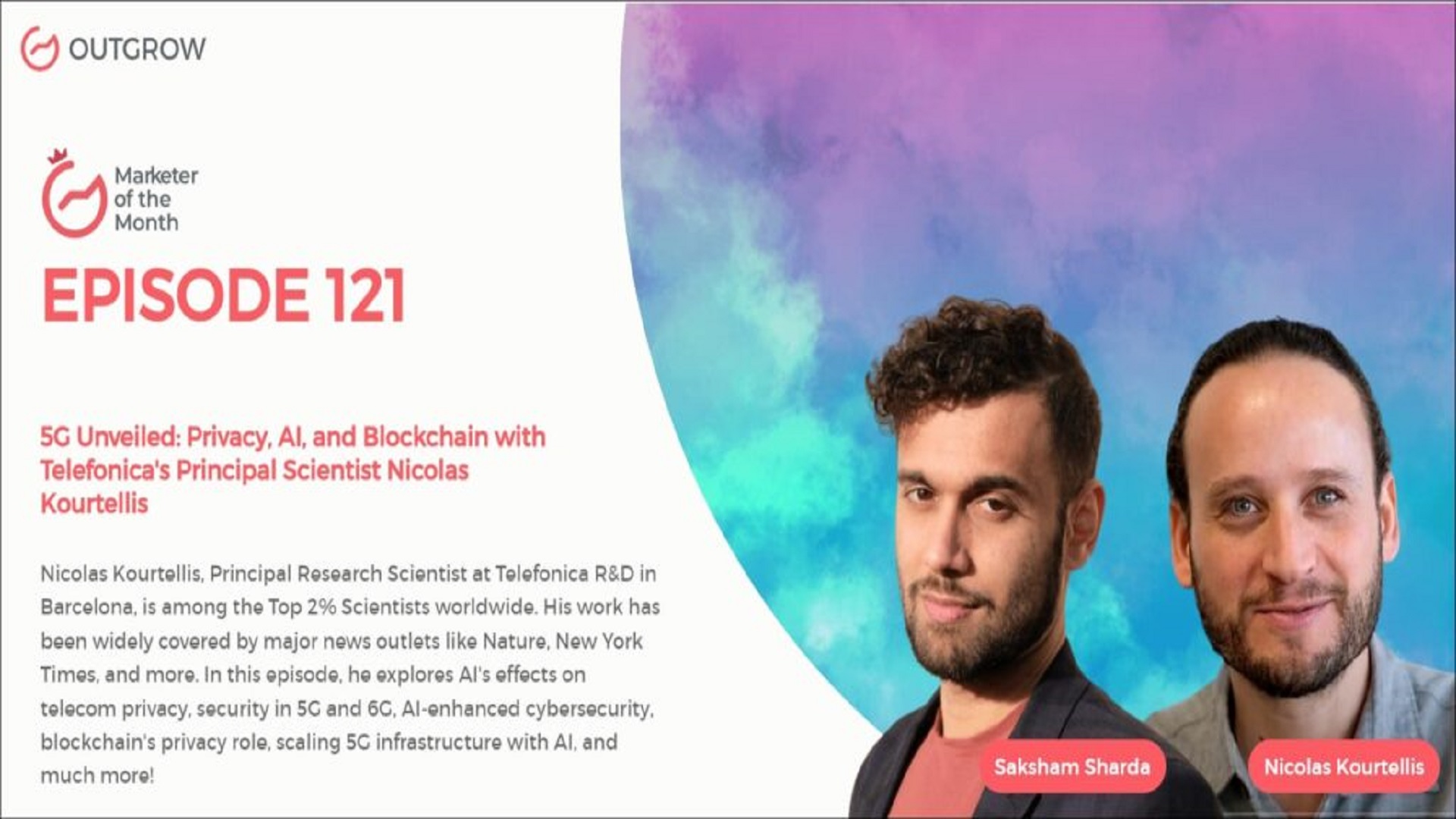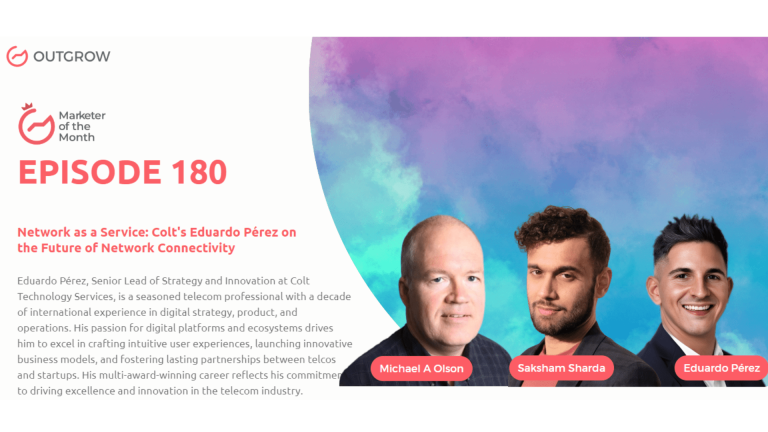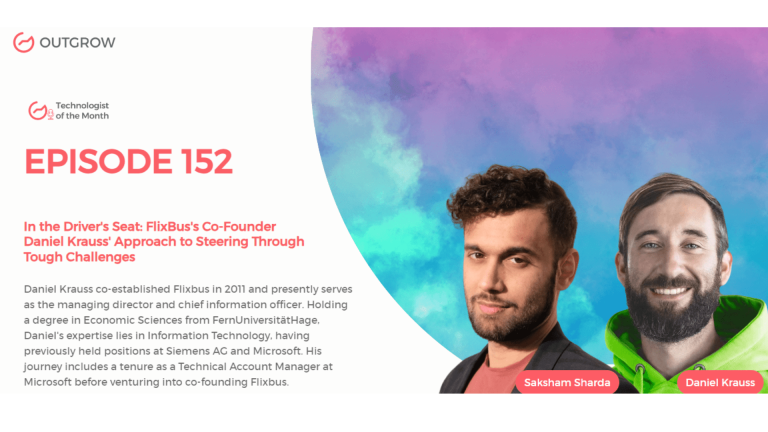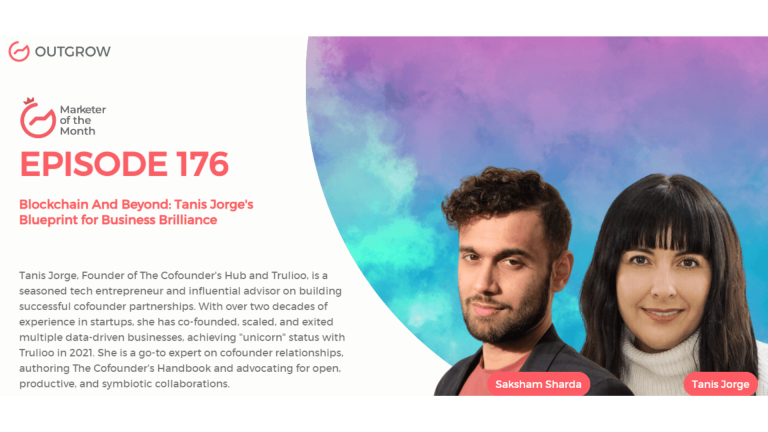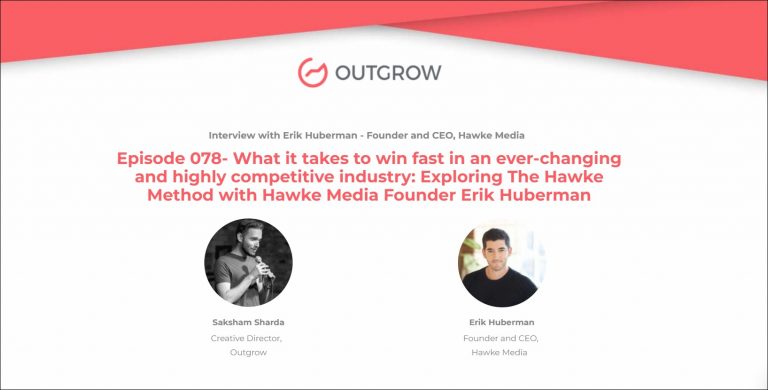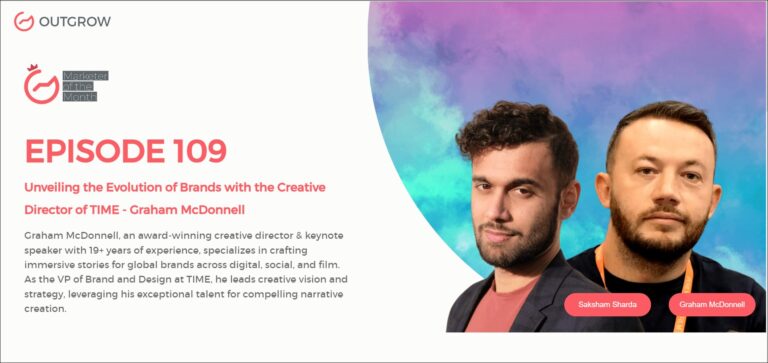EPISODE 121: Marketer of the Month Podcast with Nicolas Kourtellis
Table of Contents
Hey there! Welcome to the Marketer Of The Month blog!
We recently interviewed Nicolas Kourtellis for our monthly podcast – ‘Marketer of the Month’! We had some amazing insightful conversations with Nicolas and here’s what we discussed about-
1. AI and telecom privacy: Addressing new risks and solutions
2. Emerging 5G security: Privacy challenges and mitigation for 5G and 6G networks
3. AI for cybersecurity: Strengthening protection through artificial intelligence
4. Blockchain for privacy: Utilizing blockchain in telecom to safeguard user privacy
5. Scaling 5G infrastructure: Challenges and AI-based strategies for deployment
6. Cutting-edge research: Exploring fairness, bias, graph analysis, and distributed processing in telecom
About our host:
Dr. Saksham Sharda is the Chief Information Officer at Outgrow.co. He specializes in data collection, analysis, filtering, and transfer by means of widgets and applets. Interactive, cultural, and trending widgets designed by him have been featured on TrendHunter, Alibaba, ProductHunt, New York Marketing Association, FactoryBerlin, Digimarcon Silicon Valley, and at The European Affiliate Summit.
About our guest:
Nicolas Kourtellis, Principal Research Scientist at Telefonica R&D in Barcelona, is among the Top 2% Scientists worldwide. His work has been widely covered by major news outlets like Nature, New York Times, and more. In this episode, he explores AI’s effects on telecom privacy, security in 5G and 6G, AI-enhanced cybersecurity, blockchain’s privacy role, scaling 5G infrastructure with AI, and much more!
5G Unveiled: Privacy, AI, and Blockchain with Telefonica’s Principal Scientist Nicolas Kourtellis
The Intro!
Saksham Sharda: Hi, everyone. Welcome to another episode of Outgrow’s Marketer of the Month. I’m your host, Dr. Saksham Sharda, and I’m the creative director at Outgrow. co. And for this month we are going to interview Nicolas Kourtellis, who is Principal Research Scientist at Telefonica R&D in Barcelona.
Nicolas Kourtellis: Great to be here. Thank you.
Don’t have time to read? No problem, just watch the Podcast!
Or you can just listen to it on Spotify!
The Rapid Fire Round!
Saksham Sharda: Alright, so let’s start with the rapid-fire round. At what age do you want to retire?
Nicolas Kourtellis: I don’t know in two decades maybe.
Saksham Sharda: What’s your favorite mobile app?
Nicolas Kourtellis: Google Maps probably.
Saksham Sharda: How long does it take you to get ready in the morning?
Nicolas Kourtellis: 10 minutes.
Saksham Sharda: Most embarrassing moment of your life?
Nicolas Kourtellis: Pass.
Saksham Sharda: Mountains or beaches?
Nicolas Kourtellis: Beaches.
Saksham Sharda: What’s the most useful mobile feature you can’t live without?
Nicolas Kourtellis: The Internet.
Saksham Sharda: Favorite color?
Nicolas Kourtellis: Blue.
Saksham Sharda: What time of day are you most inspired?
Nicolas Kourtellis: Early afternoon.
Saksham Sharda: How many hours of sleep can you survive on?
Nicolas Kourtellis: Seven.
Saksham Sharda: Fill in the blank: an upcoming marketing trend is ________
Nicolas Kourtellis: Influencers.
Saksham Sharda: The city in which the best kiss of your life happened?
Nicolas Kourtellis: Pass.
Saksham Sharda: Take one Android or Apple?
Nicolas Kourtellis: Probably Android.
Saksham Sharda: The biggest mistake of your career?
Nicolas Kourtellis: Pass
Saksham Sharda: How many cups of coffee do you drink per day?
Nicolas Kourtellis: Three.
Saksham Sharda: How do you relax?
Nicolas Kourtellis: By sleeping.
Saksham Sharda: A habit of yours that you hate?
Nicolas Kourtellis: A habit of mine that I hate- working too much.
Saksham Sharda: The most valuable skill you’ve learned in life?
Nicolas Kourtellis: Never give up.
Saksham Sharda: Cities or countryside?
Nicolas Kourtellis: Cities.
Saksham Sharda: The last one is, what is your favorite Netflix show?
Nicolas Kourtellis: I cannot remember if Black Mirror was on Netflix.
The Big Questions!
Saksham Sharda: Okay that’s the end of the rapid-fire round. Okay, these other questions are long questions now. And you can answer them with as much ease and time as you like. The first one is, with the increasing use of AI and machine learning in the telecom industry, what are some new privacy risks that users may face, and how can we mitigate them?
Nicolas Kourtellis: Right. So I mean, if I take general AI, not specifically for telco or not, I would say that there are several challenges that have to do with attackers trying to reverse engineer your data or your models that are being deployed. These depend on where the attackers are if they’re on the network, if they’re on the servers if they’re on the user devices. And then the types of attacks can be trying to reverse engineer your data, trying to understand what properties the model has. Now what we can do about it is we have these different, let’s say techniques or methods or you can modify the model when you’re training these machine learning models. You can influence the model to not learn exactly the data of the user. Therefore if an attacker tries to infer something about the user data, they will not be able to distinguish the only way to understand exactly now, as you understand it’s continuing. It’s always a trade-off between privacy and how good a model is. So if you suspect that your infrastructure, your AI models will be attacked. You have to protect them with the most severe methods which may have problems. As we just picked the scalability of the models may have problems of utility, like how good the models are. So it’s always a trade-off between the two balancing.
Saksham Sharda: So with the rise of 5G and 6G networks, what are the biggest security and privacy challenges?
Nicolas Kourtellis: So what I’m expecting is that with 6G, we will be seeing a lot more. So we will have more sensing of the users and devices that they’re using, we will have smart buildings, and we will have so many things that are sensing the environment. And as well, being inside this environment, and therefore expecting that moving beyond, you know, let’s say, 4G, going to 5G, 6G, users will need to be definitely much more educated and aware that there is a risk of privacy, right? Just think about the scenario of you being more easily located. No. In 6G, there are technologies that we will understand where your hands are, you know, we’re not talking about like, where you are as a person are talking about, you know, so we are expecting that we will have this table of capabilities, and therefore, it increases the challenge of how do you protect these properties of privacy. And what people are suggesting is that we do that at the physical level. So we shouldn’t be expecting, or we shouldn’t wait for the data to be collected and go into some servers or whatever, and then analyze, we need to protect the user from the point of view of private security, at the moment when the data is being created. And that’s why we’re also proposing various methods that are more what we call distributed privacy, preserving machine learning methods, where you do these things, at the edge or even at the use of the device, and you try to protect these properties at the source.
Saksham Sharda: And in what ways can AI be used to enhance cybersecurity?
Nicolas Kourtellis: So, one way to think about it is that AI is a powerful little tool, right? And we can use it to protect the user’s privacy and security by detecting such attacks, right? So in the same way that an attacker can try to attack a model and try to understand if I am here, if I’m there, and so on, I come to have an AI module trying to detect the attacks. So it’s a very powerful kind of tool to do. You can detect anomalies in the network that in the past, you know, we’re done with heuristics with minor little rules and stuff like that which are very rigid, they cannot be adapted quickly. Right. So we say you can, of course, given the access to proper data to train the models, you could build these powerful tools that can detect the attacks, can it take normal attacks when there are some anomalies? So there is this duality of the thing. It’s not just you know, bringing, let’s say bad things, right? It also brings this power of both the users and the providers.
Saksham Sharda: So how about blockchain, the emergence of blockchain technology has been hailed as a potential solution to data privacy concerns. How do you see blockchain being used in the telecom industry to protect users’ privacy?
Nicolas Kourtellis: So the way that I see blockchain is, as I mean blockchain technologies, let’s say you have some sort of distributed ledger that tries to keep tabs on things, access to data, or something like that. Now, the way I could see the US is having some sort of blockchain technology that allows a couple of things: one is keeping track of who is accessing my data, and who is trying to share my data. This is done through these decentralized kinds of ledgers that have these immutable records, so nobody can modify them. So if you decide to access my data, I will know I will be able to know. Also, you can use project technology. There is this concept of smart contracts. And all these things that I just mentioned earlier can be dictated by smart contracts. So there are these automation methods that blockchain tools can offer and smart contracts. Then you can audit them. You can check down the road, for example, you know, governmental agencies, they want to access my data, I will be able to audit who access them when why. So there are records, right? And nobody can touch them. At least that’s in theory.
Saksham Sharda: So as telecom companies roll out new 5G infrastructure, what challenges do they face in terms of deployment and scaling? And how do they face it?
Nicolas Kourtellis: What I see is that we have these, for example, for 6G, right, 5G, we will be seeing a much larger scale of the necessity of large-scale infrastructure, right? I mentioned earlier about sensing all these things that require infrastructure. What that means is that you also need some way to manage these resources No. And if you don’t have some sort of automated way to do that, you’re gonna fail, right? So AI can help you basically solve this challenge that comes with going into 6G. Cybersecurity-wise, again, I mentioned earlier that whatever challenge comes with it, you can sort of solve it with AI. We also have this opportunity for like, doing, what we call resource management, reallocation of let’s say, bandwidth, or network infrastructure because you can use it as a service, we have this concept of government telephony as a service, there will be in the future security as a service, there will be all these concepts of providers, that could be for markets, it could be for infrastructure, so all these things can allow not only a telco player, but other industries to capitalize on AI and solve at the same time, these kinds of challenges. And yeah, last thing, there is a concept that we call software-defined networks that have been around for a while, of course, is the way of abstracting the network, as a software and kind of mix and match type of components that you need, based on the expected utilization. So for example, we are in Mobile World Congress. Now, this doesn’t happen often, it happens only once a year. So that means that during this week, you need much more infrastructure close to support, you know, hundreds of 1000s of people being so either you’re going to deploy manually a bunch of antennas, and all these things that need to support the users, or you’re going to abstract the infrastructure or the software level and shift around resources to support these users. And this kind of vision for the Congress Party is a measure for any type of activity in the future.
Saksham Sharda: And how have you addressed issues of bias and fairness in your work on data mining and machine learning on large-scale data? Can you describe a specific example of how you mitigated bias in your models?
Nicolas Kourtellis: So this is actually an area that I’m entering now with some colleagues. I know that we have this ongoing research showing understanding, fairness, and bias with respect to different pipelines that are happening in California. But beyond California, I think that is this consultative form of research to the research community to invent new methods that allow you to train a machine learning model that is more fair and less biased. The way usually to do that is to make sure that either your data is not biased, which means that you need to have some sort of balanced set of data across all your labels across all your properties, or if that is not possible, because of the data collection process to counterbalance this in the learning and in the model training. So to give you an example, if you are trying to collect census data, right, in the macro spaying, there are some areas that are very difficult to reach right there. So those areas may end up being underrepresented in the data set. Right? So, now, if you have an expectation that this is going to happen, and you can anticipate it, you can also plan some sort of weight to counteract it inside the learning, right? And we are examining all these different methods to make sure that whatever model we build on user data or infrastructure data is representative, unbiased, or, you know, they have this balance across all labels, and so on.
Saksham Sharda: The next one is about whether you can discuss your research on streaming graph analysis? What are some of the key challenges in analyzing graphs in real-time, and how have you addressed them?
Nicolas Kourtellis: Yeah, so this one is definitely some work I did in the past. And I would say that the big challenge with processing or learning on big graphs is, well, two issues. One is the scale. One is the dynamicity of the graph. So when you’re talking about, for example, social graphs. If you want to analyze the actual real-time graphs, these are constantly changing. An example of a graph is friendships. So the Facebook Graph, for example, people are becoming friends or unfriending each other all the time, right? Now, if you want to study this type of graph, and have an up-to-date set of metrics, like who is the most central in the network, or give me the top 1000 Central users, and this may be changing constantly. So your methods, your graph analysis methods need to adapt to this. This poverty, then you also have the problem of size, right? If you’re talking about a big graph, the Facebook graph is a few billion users graph. You may not be able to fit it inside one machine, right? You need a supercomputer to actually feed it. So you need to come up with clever ways to process maybe a portion of the time portion of the graph at each time and perform computations to make it possible. So to back to your question, in the past, we worked on some, let’s say difficult, centrality metrics. We invented some methods on how to compute and recompute these metrics, almost in real-time while the graph is changing and this was the challenge, how do you find a way? I don’t need to mention too much in detail.
Saksham Sharda: And how do you approach workload analysis on distributed stream processing engines? Can you describe a specific example of how you optimize the performance of the system under heavy load?
Nicolas Kourtellis: Yeah, so we did this work, it’s been also a few years, the idea is trying to first of all, accept the fact that in heavy workloads, not all the data are coming in at the same time, at the same rate, you know, so there are some data that are more popular than others. For example, if you look at Mobile World Congress, at the moment on Twitter, it’s going to be much more popular as a keyword or hashtag than, I don’t know, a random village in Catalonia, right? They both kind of happen in Catalonia, but one is much more popular. Now, if you want to process and do some sort of computations, some processing on the specific hashtags, one of them will be much more popular. So that means that you need much more computing power to do it. So some work we did there was to find a clever way to redirect, let’s say, the incoming flow of traffic coming for specific keys or keywords that are very popular and distributed across many machines, right? So the scenario there was that if you have this type of unbalanced data set, and you need to process that real-time, how do you do that without killing, you know, specific machines because they’re just getting all the load? So there was this scaling or scaling type of technique.
Saksham Sharda: And the kind of overarching question is what are some of the most exciting research questions or areas of inquiry in your field right now?
Nicolas Kourtellis: But I mean, it depends on if we talk about computer science in general, or if we talk about my field. I think in my field, I’m focusing on security and privacy in AI and the web. We have these techniques for privacy-preserving machine learning, and we are looking to federated learning. So I’m doing a lot of work on that. And I think it’s one of the very promising ways to train AI models at the edge, the user’s devices, and so on. There are, of course, the things that I mentioned at the very beginning, adversarial attacks, and how do you detect them? How do you protect the users from this type of attack, then as if I kind of step away from the security and privacy, I think there is the general concept of quantum computing, which is becoming more and more of a reality, people are looking to do much more. As well as something that’s also relevant to 6G, which has to do with coming up with ways to communicate between point to point in a very fast way, we are talking about reaching terahertz, terabit type of speeds. There were some reports recently from China, I think that they achieved it, but we’re talking about having it at the production level, we’re still experimental. So figuring out how to do this high bandwidth and high low latency type of communications. And also the infrastructure point of view. So edge to cloud, and how do you move computation from the edge to the cloud and back and forth? So we actually have some projects that are, let’s say, focusing on figuring out that because the traditional way so far was, okay, let me collect everything to the cloud computer there, and then maybe I’ll send it to the devices, but people discovered that you could not do that because it is not scalable. So, let me push something back to the edge. So there is this edge-to-cloud type of new way of thinking. And that means there is a lot of research to be done at the edge to understand what we can do, and how we can optimize the training of the models. There is a lot of work to be done on how to optimize the computation of the cloud. And they move back and forth right to orchestrate this workload.
Saksham Sharda: Okay, so the last question is more of a personal kind. Okay. What would you be doing in your life? If not this right now?
Nicolas Kourtellis: Probably singing and dancing.
Let’s Conclude!
Saksham Sharda: Thanks, everyone for joining us for this month’s episode of Outgrow’s Marketer of the Month. That was Nicolas Kourtellis, Principal Research Scientist at Telefonica R&D in Barcelona.
Nicolas Kourtellis: Pleasure. Thanks for having me.
Saksham Sharda: Check out the website for more details and we’ll see you once again next month with another marketer of the month.

